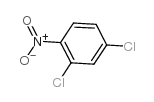2,4-二氯硝基苯
一般危化品

2,4-二氯硝基苯结构式
|
常用名 | 2,4-二氯硝基苯 | 英文名 | 2,4-Dichloronitrobenzene |
|---|---|---|---|---|
| CAS号 | 611-06-3 | 分子量 | 192.00000 | |
| 密度 | 1.479 | 沸点 | 258 °C(lit.) | |
| 分子式 | C6H3Cl2NO2 | 熔点 | 29-32 °C(lit.) | |
| MSDS | 中文版 美版 | 闪点 | >230 °F | |
| 符号 |

GHS07 |
信号词 | Warning |
|
Control of the immune response to contact sensitizing chemicals by cutaneous antigen-presenting cells.
Br. J. Dermatol. 117(1) , 1-9, (1987) The fate of 2,4-dinitrochlorobenzene, a potent contact sensitizing chemical, and 2,4-dichloronitrobenzene, a non-sensitizer, was compared following their application to the skin of BALB/c mice. Although both chemicals were able to bind to protein in vitro and... |
|
|
Contribution of caffeine and flavanols in the induction of hepatic Phase II activities by green tea.
Food Chem. Toxicol. 36(8) , 617-21, (1998) Aqueous extracts of green tea, at concentrations of 2.5. 5.0 and 7.5%, were administered to rats as the sole drinking fluid for 4 weeks. Hepatic glutathione S-transferase (GST) activity, determined using 1-chloro-2,4-dinitrobenzene (CDNB) and 3,4-dichloronitr... |
|
|
Dose-response effects of lycopene on selected drug-metabolizing and antioxidant enzymes in the rat.
Cancer Lett. 154(2) , 201-10, (2000) The administration of lycopene to female rats at doses ranging from 0.001 to 0.1 g/kg b.w. per day for 2 weeks was found to alter the drug-metabolizing capacity and antioxidant status of the exposed animals. An investigation of four cytochrome P450-dependent ... |
|
|
Dinitrochlorobenzene is inherently mutagenic in the presence of trace mutagenic contaminants.
Arch. Dermatol. 124(3) , 396-8, (1988) 2,4-Dinitrochlorobenzene (DNCB) is used for immunotherapy of alopecia areata and verruca vulgaris. We initially postulated that the presence of mutagenic contaminants in commercially available DNCB might account for part of its mutagenicity. We have now chara... |
|
|
Investigating protein haptenation mechanisms of skin sensitisers using human serum albumin as a model protein.
Toxicol. In Vitro 21(4) , 723-33, (2007) Covalent modification of skin proteins by electrophiles is a key event in the induction of skin sensitisation but not skin irritation although the exact nature of the binding mechanisms has not been determined empirically for the vast majority of sensitisers.... |
|
|
Mass spectrometric identification of covalent adducts of the skin allergen 2,4-dinitro-1-chlorobenzene and model skin proteins.
Toxicol. In Vitro 22(5) , 1169-76, (2008) A large proportion of allergic skin reactions are considered to be the result of skin exposure to small organic chemicals that possess the intrinsic ability to covalently modify skin proteins, either directly or following activation. In the absence of informa... |
|
|
Differential modulation of CXCR4 and CD40 protein levels by skin sensitizers and irritants in the FSDC cell line.
Toxicol. Lett. 177(1) , 74-82, (2008) The development of non-animal methods for skin sensitization testing is an urgent challenge. Some of the most promising in vitro approaches are based on the analysis of phenotypical and functional modifications induced by sensitizers in dendritic cell models.... |
|
|
Ammonium 4-chloro-7-sulfobenzofurazan: a fluorescent substrate highly specific for rat glutathione S-transferase subunit 3.
Anal. Biochem. 216(2) , 418-23, (1994) Ammonium 4-chloro-7-sulfobenzofurazan (Sbf-Cl) is a water-soluble fluorescent reagent which is highly specific for thiol groups. We describe here a simple and sensitive fluorescence assay which is highly specific for subunit 3 of the rat glutathione S-transfe... |
|
|
2,4-Dichloro-1-nitrobenzene exerts carcinogenicities in both rats and mice by two years feeding.
Arch. Toxicol. 86(11) , 1763-72, (2012) Carcinogenicity and chronic toxicity of 2,4-dichloro-1-nitrobenzene (2,4-DCNB) were examined by dietary administration to F344/DuCrj rats and Crj:BDF(1) mice of both sexes for 2 years. Dietary administration commenced when the animals were 6 weeks old. The di... |
|
|
Identification of an N-acetylcysteine conjugate in the urine after oral administration of 2,4-dichloro-1-nitrobenzene to rats.
J. Toxicol. Sci. 34(2) , 233-7, (2009) Oral administration of 2,4-dichloro-1-nitrobenzene (2,4-DCNB) causes kidney tumors in the rat. The objective of the present study was to identify the chemical structure of 2,4-DCNB metabolites in urine. Urine from 2,4-DCNB fed rats was more yellow than urine ... |